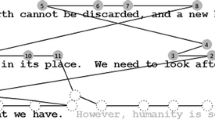Abstract
What-you-see-is-what-you-get word processing editors that support the typesetting of mathematical content allow for direct manipulation of 2-dimensional mathematical notation within a 1-dimensional environment. The models used to represent mathematical structure generally fall into two categories: (1) free-form, in which symbols are placed and moved freely in the workspace and (2) structure-based, where 2-dimensional structures are inserted and then populated with other structures or symbols. To understand the consequences of these models for writing mathematical expressions we examined the sequential order of symbol insertion when transcribing fractions, and compare this to the natural order employed when handwritten. Markov transition matrices were created from recordings of fraction transcriptions to quantify the probability of inserting a symbol immediately following insertion of other symbols. The three writing techniques yielded different dominant transition patterns and also differed in their ability to tolerate differences from the dominant pattern. This study likely represents the first empirical assessment of symbol insertion order probabilities when handwriting fractions, while also identifying differences in insertion order during use of different types of digital editors for typesetting mathematical content. These results have important implications for the usability of mathematical typesetting software applications and should be considered in the future design of such programs.
Access this chapter
Tax calculation will be finalised at checkout
Purchases are for personal use only
Similar content being viewed by others
References
Charalambous, C.Y., Pitta-Pantazi, D.: Drawing on a theoretical model to study students’ understandings of fractions. Educ. Stud. Math. 64(3), 293–316 (2007)
Davis, G., Hunting, R.P., Pearn, C.: What might a fraction mean to a child and how would a teacher know? J. Math. Behav. (1993)
Gillan, D.J., Barraza, P., Karshmer, A.I., Pazuchanics, S.: Cognitive analysis of equation reading: application to the development of the math genie. In: Miesenberger, K., Klaus, J., Zagler, W.L., Burger, D. (eds.) ICCHP 2004. LNCS, vol. 3118, pp. 630–637. Springer, Heidelberg (2004). https://doi.org/10.1007/978-3-540-27817-7_94
Gozli, D.G., Pollanen, M., Reynolds, M.: The characteristics of writing environments for mathematics: behavioral consequences and implications for software design and usability. In: Carette, J., Dixon, L., Coen, C.S., Watt, S.M. (eds.) CICM 2009. LNCS (LNAI), vol. 5625, pp. 310–324. Springer, Heidelberg (2009). https://doi.org/10.1007/978-3-642-02614-0_26
Hinze-Hoare, V.: The review and analysis of human computer interaction (HCI) principles. arXiv preprint arXiv:0707.3638 (2007)
Jansen, A.R., Marriott, K., Yelland, G.W.: Parsing of algebraic expressions by experienced users of mathematics. Eur. J. Cogn. Psychol. 19(2), 286–320 (2007)
Kang, S., Pollanen, M., Damouras, S., Cater, B.: Mathematics classroom collaborator (MC\(^2\)): technology for democratizing the classroom. In: Davenport, J.H., Kauers, M., Labahn, G., Urban, J. (eds.) ICMS 2018. LNCS, vol. 10931, pp. 280–288. Springer, Cham (2018). https://doi.org/10.1007/978-3-319-96418-8_33
Kim, S., Pollanen, M., Reynolds, M.G., Burr, W.S.: Identification of errors in mathematical symbolism and notation: implications for software design. In: Davenport, J.H., Kauers, M., Labahn, G., Urban, J. (eds.) ICMS 2018. LNCS, vol. 10931, pp. 297–304. Springer, Cham (2018). https://doi.org/10.1007/978-3-319-96418-8_35
Kim, S., Pollanen, M., Reynolds, M.G., Burr, W.S.: Problem solving as a path to comprehension. Mathemat. Comput. Sci. 14(3), 607–621 (2020)
Knauff, M., Nejasmic, J.: An efficiency comparison of document preparation systems used in academic research and development. PLoS ONE 9(12), e115069 (2014)
Murphy, D., Kember, D.: Mathematical typesetting from an operator perspective. Educ. Technol. 29(4), 40–44 (1989)
Nielsen, J.: Usability Engineering. Morgan Kaufmann, Burlington (1994)
Pantziara, M., Philippou, G.: Levels of students’ “conception’’ of fractions. Educ. Stud. Math. 79(1), 61–83 (2012)
Pollanen, M., Kang, S., Cater, B., Chen, Y., Lee, K.: MC\(^2\): mathematics classroom collaborator. In: Proceedings of the Workshop on Mathematical User Interfaces (2017)
Quinby, F.: Characteristics of models for representation of mathematical structure in typesetting applications and the cognition of digitally transcribing mathematics. Master’s thesis, Trent University, Canada (2020)
Quinby, F., Kim, S., Kang, S., Pollanen, M., Reynolds, M.G., Burr, W.S.: Markov transition matrix analysis of mathematical expression input models. In: Bigatti, A.M., Carette, J., Davenport, J.H., Joswig, M., de Wolff, T. (eds.) ICMS 2020. LNCS, vol. 12097, pp. 451–461. Springer, Cham (2020). https://doi.org/10.1007/978-3-030-52200-1_45
Quinby, F., Kim, S., Pollanen, M., Burr, W.S., Reynolds, M.G.: An evaluation of two-dimensional digital input models for mathematical structure: effects on working memory, cognitive load, and efficiency. In: Harris, D., Li, W.-C. (eds.) HCII 2021. LNCS (LNAI), vol. 12767, pp. 212–222. Springer, Cham (2021). https://doi.org/10.1007/978-3-030-77932-0_18
Quinby, F., Pollanen, M., Reynolds, M.G., Burr, W.S.: Effects of digitally typesetting mathematics on working memory. In: Harris, D., Li, W.-C. (eds.) HCII 2020. LNCS (LNAI), vol. 12186, pp. 69–80. Springer, Cham (2020). https://doi.org/10.1007/978-3-030-49044-7_7
Shin, J., Lee, S.J.: The alignment of student fraction learning with textbooks in Korea and the United States. J. Math. Behav. 51, 129–149 (2018)
Tsai, T.-L., Li, H.-C.: Towards a framework for developing students’ fraction proficiency. Int. J. Math. Educ. Sci. Technol. 48(2), 244–255 (2017)
Author information
Authors and Affiliations
Corresponding author
Editor information
Editors and Affiliations
Rights and permissions
Copyright information
© 2022 The Author(s), under exclusive license to Springer Nature Switzerland AG
About this paper
Cite this paper
Quinby, F., Pollanen, M., Burr, W.S., Reynolds, M.G. (2022). Do Mathematical Typesetting Applications Affect User Manipulation of Fractions? Evidence from an Eye-Tracking Experiment. In: Harris, D., Li, WC. (eds) Engineering Psychology and Cognitive Ergonomics. HCII 2022. Lecture Notes in Computer Science(), vol 13307. Springer, Cham. https://doi.org/10.1007/978-3-031-06086-1_8
Download citation
DOI: https://doi.org/10.1007/978-3-031-06086-1_8
Published:
Publisher Name: Springer, Cham
Print ISBN: 978-3-031-06085-4
Online ISBN: 978-3-031-06086-1
eBook Packages: Computer ScienceComputer Science (R0)




